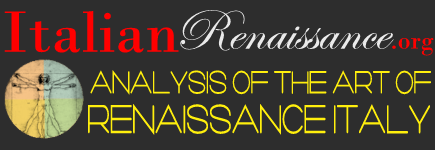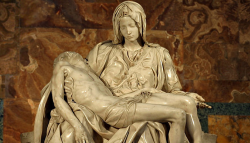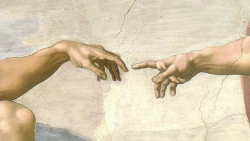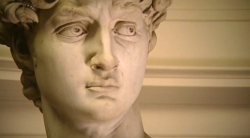Now, while this work continued to be carried forward, he made a panel for the Nuns of S. Giorgio, and three half-length figures in an arch over the inner side of the door of the Badia in Florence, now covered with whitewash in order to give more light to the church. And in the Great Hall of the Podestà of Florence he painted the Commune (an idea stolen by many), representing it as sitting in the form of Judge, sceptre in hand, and over its head he placed the balanced scales as symbol of the just decisions administered by it, accompanying it with four Virtues, that are, Strength with courage, Wisdom with the laws, Justice with arms, and Temperance with words; this work is beautiful as a picture, and characteristic and appropriate in invention.
Afterwards, having gone again to Padua, besides many other works and chapels that he painted there, he made a Mundane Glory in the precincts of the Arena, which gained him much honour and profit. In Milan, also, he wrought certain works, that are scattered throughout that city and held most beautiful even to this day. Finally, having returned from Milan, no long time passed before he gave up his soul to God, having wrought so many most beautiful works in his life, and having been no less good as Christian than he was excellent as painter. He died in the year 1336, to the great grief of all his fellow-citizens—nay, of all those who had known him or even only heard his name—and he was buried, even as his virtues deserved, with great honour, having been loved by all while he lived, and in particular by the men excellent in all the professions,[Pg 89] seeing that, besides Dante, of whom we have spoken above, he was much honoured by Petrarca, both he and his works, so greatly that it is read in Petrarca’s testament that he left to Signor Francesco da Carrara, Lord of Padua, among other things held by him in the highest veneration, a picture by the hand of Giotto containing a Madonna, as something rare and very dear to him. And the words of that clause in the testament run thus:
“Transeo ad dispositionem aliarum rerum; et prædicto igitur domino meo Paduano, quia et ipse per Dei gratiam non eget, et ego nihil aliud habeo dignum se, mitto tabulam meam sive historiam Beatæ Virginis Mariæ, opus Jocti pictoris egregii, quæ mihi ab amico meo Michæle Vannis de Florentia missa est, in cujus pulchritudinem ignorantes non intelligunt, magistri autem artis stupent; hanc iconam ipsi domino lego, ut ipsa Virgo benedicta sibi sit propitia apud filium suum Jesum Christum.”
And the same Petrarch, in a Latin epistle in the fifth book of his Familiar Letters, says these words:
“Atque (ut a veteribus ad nova, ab externis ad nostra transgrediar) duos ego novi pictores egregios, nec formosos, Joctum Florentinum civem, cujus inter modernos fama ingens est, et Simonem Senensem. Novi scultores aliquot,” etc.
Giotto was buried in S. Maria del Fiore, on the left side as you enter the church, where there is a slab of white marble in memory of so great a man. And, as was told in the Life of Cimabue, a commentator of Dante, who lived at the same time as Giotto, said: “Giotto was and is the most eminent among painters in the same city of Florence, and his works bear testimony for him in Rome, in Naples, in Avignon, in Florence, in Padua, and in many other parts of the world.”
His disciples were Taddeo Gaddi, held by him at baptism, as has been said, and Puccio Capanna of Florence, who, working at Rimini in the Church of S. Cataldo, belonging to the Preaching Friars, painted perfectly in fresco the hull of a ship which appears to be sinking in the sea, with men who are throwing things into the sea, one of whom is Puccio himself portrayed from life among a good number of mariners. The same man[Pg 90] painted many works after the death of Giotto in the Church of S. Francesco at Assisi, and in the Church of S. Trinita in Florence, near the side-door towards the river, he painted the Chapel of the Strozzi, wherein is the Coronation of the Madonna in fresco, with a choir of angels which draw very much to the manner of Giotto; and on the sides are stories of S. Lucia, very well wrought. In the Badia of Florence he painted the Chapel of S. Giovanni Evangelista, belonging to the family of Covoni, beside the sacristry; and in Pistoia he wrought in fresco the principal chapel of the Church of S. Francesco and the Chapel of S. Lodovico, with the stories of those Saints, passing well painted. In the middle of the Church of S. Domenico, in the same city, there are a Crucifix, a Madonna, and a S. John, wrought with much sweetness, and at their feet a complete human skeleton, wherein (and this was something unusual in those times) Puccio showed that he had sought to find the foundations of art. In this work there is read his name, written by himself in this fashion: PUCCIO DI FIORENZA ME FECE. In the arch over the door of S. Maria Nuova in the said church there are three half-length figures by his hand, Our Lady with the Child in her arms, and S. Peter on one side, and on the other S. Francis. He also painted in the aforesaid city of Assisi, in the lower Church of S. Francesco, some scenes of the Passion of Jesus Christ in fresco, with good and very resolute mastery, and in the chapel of the Church of S. Maria degli Angeli he wrought in fresco a Christ in Glory, with the Virgin praying to Him for the Christian people; this work, which is passing good, has been all blackened by the smoke of the lamps and the candles that are burning there continually in great quantity. And in truth, in so far as it can be judged, Puccio had the manner and the whole method of working of his master Giotto, and knew how to make good use of it in the works that he wrought, even if, as some have it, he did not live long, having fallen sick and died by reason of labouring too much in fresco. By his hand, in so far as is known, is the Chapel of S. Martino in the same church, with the stories of that Saint, wrought in fresco for Cardinal Gentile. There is seen, also, in the middle of the street called Portica, a Christ at the Column, and in a square picture there is Our Lady, with S. Catherine and S. Clara, one on either side of[Pg 91] her. There are works by his hand scattered about in many other places, such as a panel with the Passion of Christ, and stories of S. Francis, in the tramezzo[13] of the church in Bologna; and many others, in short, that are passed by for the sake of brevity. I will say, indeed, that in Assisi, where most of his works are, and where it appears to me that he assisted Giotto in painting, I have found that they hold him as their fellow-citizen, and that there are still to-day in that city some of the family of the Capanni. Wherefore it may easily be believed that he was born in Florence, having written so himself, and that he was a disciple of Giotto, but that afterwards he took a wife in Assisi, that there he had children, and that now he has descendants there. But because it is of little importance to know this exactly, it is enough to say that he was a good master.
Likewise a disciple of Giotto and a very masterly painter was Ottaviano da Faenza, who painted many works at Ferrara in S. Giorgio, the seat of the Monks of Monte Oliveto; and in Faenza, where he lived and died, he painted, in the arch over the door of S. Francesco, a Madonna, S. Peter and S. Paul, and many other works in his said birthplace and in Bologna.
A disciple of Giotto, also, was Pace da Faenza, who stayed with him long and assisted him in many works; and in Bologna there are some scenes in fresco by his hand on the façade of S. Giovanni Decollato. This Pace was an able man, particularly in making little figures, as can be seen to this day in the Church of S. Francesco at Forlì, in a Tree of the Cross, and in a little panel in distemper, wherein is the life of Christ, with four little scenes from the life of Our Lady, all very well wrought. It is said that he wrought in fresco, in the Chapel of S. Antonio at Assisi, some stories of the life of that Saint, for a Duke of Spoleto who is buried in that place together with his son, both having died fighting in certain suburbs of Assisi, according to what is seen in a long inscription that is on the sarcophagus of the said tomb. In the old book of the Company of Painters it is found that the same man had another disciple, Francesco, called di Maestro Giotto, of whom I have nothing else to relate.
Guglielmo of Forlì was also a disciple of Giotto, and besides many other works he painted the chapel of the high-altar in S. Domenico at Forlì, his native city. Disciples of Giotto, also, were Pietro Laurati and Simon Memmi of Siena, Stefano, a Florentine, and Pietro Cavallini, a Roman; but, seeing that of all these there is account in the Life of each one of them, let it suffice to have said in this place that they were disciples of Giotto, who drew very well for his time and for that manner, whereunto witness is borne by many sheets of parchment drawn by his hand in water-colour, outlined with the pen, in chiaroscuro, with the high lights in white, which are in our book of drawings, and are truly a marvel in comparison with those of the masters that lived before him.



